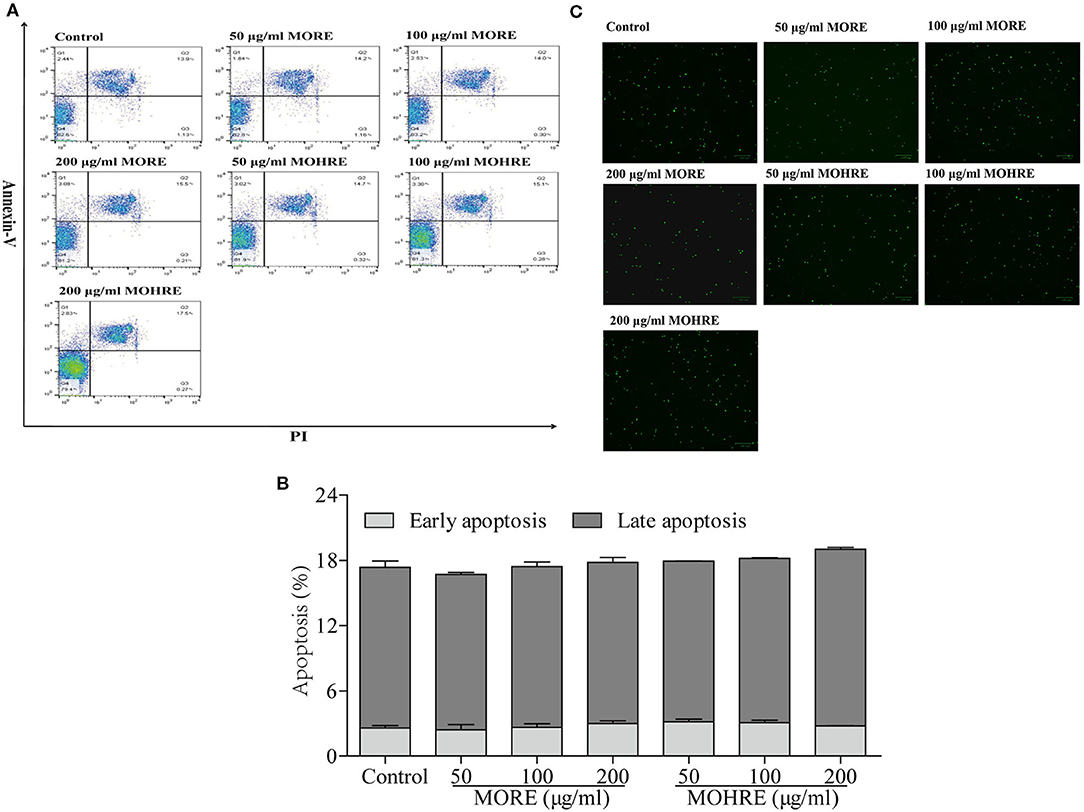The Extracts of Morinda officinalis and Its Hairy Roots Attenuate Dextran Sodium Sulfate-Induced Chronic Ulcerative Colitis in Mice by Regulating Inflammation and Lymphocyte Apoptosis
- 1Guangdong Provincial Key Laboratory of New Chinese Medicinals Development and Research, Guangzhou University of Chinese Medicine, Guangzhou, China
- 2Shenzhen Fan Mao Pharmaceutical Co., Limited, Shenzhen, China
- 3Affiliated Huai'an Hospital of Xuzhou Medical University, Huai'an, China
- 4Section of Immunology, Guangdong Provincial Academy of Chinese Medical Sciences, Guangdong Provincial Hospital of Chinese Medicine, Guangzhou, China
by Liang, J., Liang, J., Hao, H., Lin, H., Wang, P., Wu, Y., et al. (2017). Front. Immunol. 8:905. doi: 10.3389/fimmu.2017.00905
In the original article, there was a mistake in Figure 10C as published. One image (MORE, 200 μg/ml) was mistakenly duplicated from another image (Control) during the figure preparation. The corrected Figure 10 appears below.

Figure 10. The apoptosis effect of root extract of Morinda officinalis (MORE) and hairy root extract of M. officinalis (MOHRE) on normal splenic lymphocytes. (A) Representative FACS picture in each group. (B) Apoptosis assay. (C) Representative images were obtained using a fluorescence microscope (100μm). All data are expressed as mean ± S.E.M of three independent experiments. *p < 0.05, **p < 0.01 vs. control group.
The authors apologize for this error and state that this does not change the scientific conclusions of the article in any way. The original article has been updated.
Keywords: Morinda officinalis, hairy roots culture, ulcerative colitis, anti-inflammatory, immunoregulatory, apoptosis
Citation: Liang J, Liang J, Hao H, Lin H, Wang P, Wu Y, Jiang X, Fu C, Li Q, Ding P, Liu H, Xiong Q, Lai X, Zhou L, Chan S and Hou S (2020) Corrigendum: The Extracts of Morinda officinalis and Its Hairy Roots Attenuate Dextran Sodium Sulfate-Induced Chronic Ulcerative Colitis in Mice by Regulating Inflammation and Lymphocyte Apoptosis. Front. Immunol. 11:2092. doi: 10.3389/fimmu.2020.02092
Received: 22 June 2020; Accepted: 31 July 2020;
Published: 11 September 2020.
Edited and reviewed by: Jixin Zhong, Case Western Reserve University, United States
Copyright © 2020 Liang, Liang, Hao, Lin, Wang, Wu, Jiang, Fu, Li, Ding, Liu, Xiong, Lai, Zhou, Chan and Hou. This is an open-access article distributed under the terms of the Creative Commons Attribution License (CC BY). The use, distribution or reproduction in other forums is permitted, provided the original author(s) and the copyright owner(s) are credited and that the original publication in this journal is cited, in accordance with accepted academic practice. No use, distribution or reproduction is permitted which does not comply with these terms.
*Correspondence: Lian Zhou, zl@gzucm.edu.cn; Shamyuen Chan, samchan@phytogaa.com; Shaozhen Hou, hsz0214@gzucm.edu.cn
†These authors have contributed equally to this work
 Jian Liang1†
Jian Liang1†